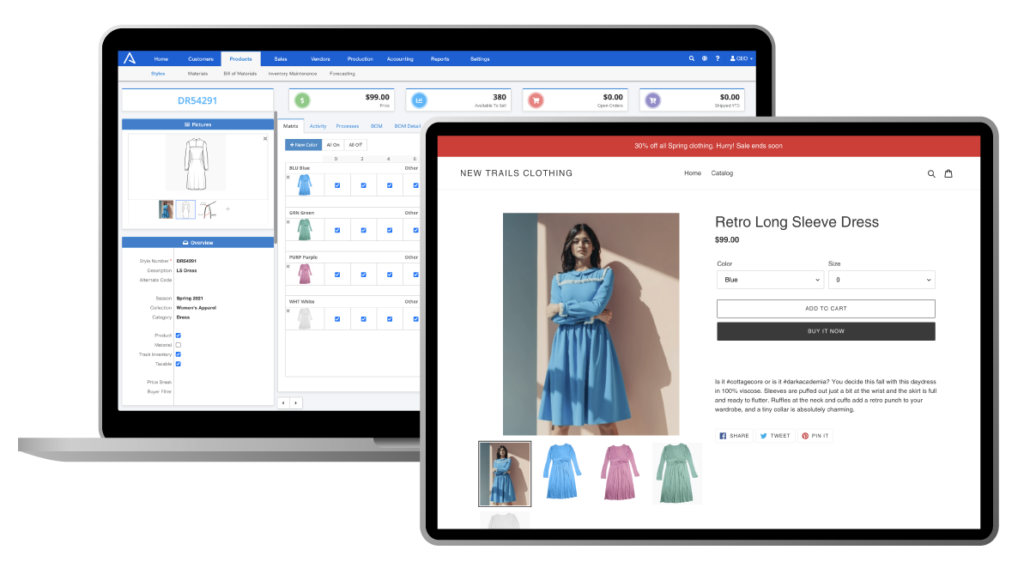The fashion industry is worth $3.5 trillion, which makes it one of the world’s greatest business sectors, right after the automobile and technology industries. However, it is also one of the most wasteful industries, contributing 10% of carbon emissions and 20% of the world’s water waste. In addition, roughly 60% of all apparel made ends up in landfills or incinerators within a few years of production.
Fortunately, mentality shifts are emerging that have the potential to transform this model over time. Increased environmental awareness combined with innovative new technology in fashion is paving the way toward a more sustainable fashion industry and ecosystem.
In this post, we’re explaining what sustainable fashion is and sharing 6 ways technology contributes to sustainability in the fashion industry.

Photo by Mel Poole on Unsplash
What is Sustainable Fashion?
The creation of clothing, footwear, accessories, and makeup in an environmentally responsible manner is referred to as sustainable fashion. The objectives of the sustainable fashion industry include protecting the environment, reducing pollution, promoting recycling, repurposing, and less consumption, as well as responsible use of natural resources.
The use of recycled materials, biodegradable textiles, local manufacturing, eco-friendly packaging, repurposed clothing, and second-hand shopping are a few examples of sustainable fashion practices. These methods must be used throughout the whole clothing production process—from design and manufacturing to packaging and distribution—for fashion to be sustainable. The good news is that technology and fashion do go hand in hand, which means that technological advancements make it simpler to implement these practices.
Why is Sustainable Technology in the Fashion Industry Important?
All fashion businesses should be looking for ways to lessen the environmental impact of their operations and contribute to a more sustainable fashion industry. Not only because it is ethically right to do so, but also because it might be crucial for business success.
According to McKinsey, over 60% of shoppers give the environmental impact a high priority when making a purchase, and according to Neilsen, more than 65% of consumers are willing to pay more for goods that are made sustainably.
There is pressure to reduce fabric waste and emissions, especially for online businesses given the additional environmental cost of exorbitantly high return rates. Adopting sustainable practices is therefore regarded as one of the best eCommerce conversion hacks for those trying to increase their online sales.
But it’s also important to embrace digital change to stop wasteful behaviors in the larger fashion industry. As consumers grow more environmentally concerned, some of the most popular brands are moving away from the wasteful methods of the past and embracing sustainable technology in the fashion industry to help bring about significant improvements. By combining technology and fashion, businesses can also address a wide range of expensive problems such as overproduction, low consumer confidence, and high return rates, while at the same time increasing productivity and efficiency. Utilizing emerging technologies will benefit all parties involved in the supply chain, eventually benefiting consumers as well.
6 Ways Technology in Fashion Industry Can Make Your Business More Sustainable
Here is a list of 6 innovative technologies revolutionizing apparel production that will help you learn more about how to support sustainability in the fashion industry.
1. Inventory Management System (IMS)
Inventory management software provides precise stock levels at the specified timeline and in the specified location or channel. The system aids in forecasting demand and producing precise reports based on an exact stock, historical data, and other pertinent aspects.
IMS also guarantees order accuracy, ensuring that the right goods reach the right customers. To make all of this possible, it must be integrated with your ERP system, eCommerce platform, and other applications the apparel company uses.
2. Alternative Textiles
The textiles and materials that are commonly used in the fashion industry take lots of resources and/or a very long time to degrade. For instance, the amount of water needed to make a single cotton shirt is equal to what one person would drink in more than two years.
With the development of sustainable technology in the fashion industry, new alternative textiles and sustainable materials are being offered that are recyclable, reusable, regenerable, and sourced ethically. Recycled fibers as well as fibers derived from agricultural waste materials, such as rinds and leaves, are just two examples of eco-friendly textile substitutes. As alternatives to cotton, many apparel businesses choose natural materials like bamboo, ramie, and hemp. These innovative textiles provide alternatives that are durable, biodegradable, and produce less waste during production.
3. Virtual Sampling
Samples give designers and retail buyers an accurate depiction of the product, and one finished style can require more than twenty samples before production.
Physical samples were once required for the design, buying, and selling lifecycles. These days, as 3D tech advances, virtual sampling provides a digital clothing review, which minimizes waste in both design and product development. The savings on labor and materials needed to produce physical samples is another significant benefit.
4. CGI Models
Did you know that the Fashion Week shows produce tons of material waste and 37% of the yearly worldwide carbon emissions? Some fashion designers have started using CGI models to showcase digital clothing and reduce their carbon footprint.
Since many of these CGI models have their own social media pages and sizable online fan bases, designers can reach a larger audience than if they were to take part in actual fashion shows. In addition, because virtual models are dressed in clothing that hasn’t been made yet, they contribute to a reduction in textile waste and efficient resource management of water and energy.
5. Making Fashion Circular
As customers and fashion companies become more conscious of the vast quantity of garbage produced by the fashion sector, new attempts are being made to solve this issue. The Make Fashion Circular campaign was launched by major brands like Stella McCartney, Nike, Burberry, H&M, and Gap in an effort to promote sustainable fashion.
The circular economy concept strives to keep materials and goods in use for as long as feasible by designing waste out of the product and manufacturing chain. This is achieved by recycling old clothing into a new one and using sustainable materials.

Photo by piotr szulawski on Unsplash
6. AI Returns Technology
Product returns produce five billion pounds of landfill waste annually and a carbon footprint of 15 million tons in the US alone.
Fortunately, hundreds of clothing companies have already been able to do this thanks to return technology. Using cloud-based software and smart algorithms, this invention diverts returns from landfills and sends them to stores, refurbishment facilities, and nonprofit groups.
Artificial intelligence can also be used to reduce return rates. Customers return clothes for a variety of reasons, including poor fit and lengthy delivery times. Brands can use artificial intelligence to implement customer database segmentation and learn precisely why and what types of customers are returning. With the use of this technology, shops will be able to choose more intelligently when it comes to advertising, quality assurance, and product display.
Final Thoughts
Sustainable fashion means being environmentally and socially responsible. Being part of the transition towards a more sustainable fashion industry is aligned with the principles of a circular economy that regenerates, restores, and helps the environment, society, and businesses.
As customers continue demanding sustainability in the fashion industry, the industry will need to adapt to meet and surpass their demands. Eco-friendliness will surely be a key component in the future of fashion, in both design and delivery.





















